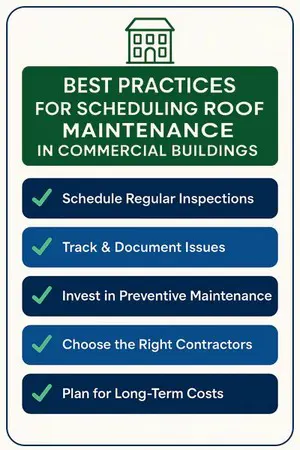
Best Practices for Scheduling Roof Maintenance and Inspections in Commercial Buildings
Commercial buildings require consistent roof maintenance to prevent costly damage, extend lifespan, and ensure structural integrity. Unlike residential properties, commercial roofs face unique challenges due to their size, materials, and exposure to environmental stressors. A well-planned maintenance and inspection schedule can help property managers mitigate risks and reduce long-term repair costs. Here are the best practices for scheduling roof maintenance and inspections in commercial buildings.
1. Establish a Regular Inspection Schedule
Routine inspections are crucial to identifying potential issues before they escalate into major problems. Industry best practices recommend:
- Biannual Inspections: Conduct thorough roof inspections at least twice a year—once in the spring and once in the fall. These seasons are ideal because they allow you to assess damage from winter storms and prepare for extreme summer heat.
- Post-Storm Inspections: Severe weather events, such as heavy rains, snowstorms, hail, and high winds, can cause immediate and hidden damage. Schedule inspections after major storms to identify and address any new issues.
- Periodic Walkthroughs: Conduct informal checks throughout the year, especially after roof access for HVAC maintenance, solar panel work, or other activities.
2. Create a Comprehensive Inspection Checklist
To ensure consistency, use a structured checklist during inspections. Key elements to assess include:
- Roof Membrane or Surface: Look for cracks, blisters, pooling water, and punctures.
- Flashing and Sealants: Check for gaps, corrosion, or deterioration around vents, chimneys, and skylights.
- Drainage Systems: Ensure gutters, downspouts, and drains are clear of debris to prevent water accumulation.
- Interior Ceilings and Walls: Inspect for water stains, mold, or other signs of leaks.
- Roof Penetrations: Examine vents, HVAC units, and any other structures for proper sealing.
- Structural Integrity: Look for sagging, uneven surfaces, or weakened support beams.
3. Schedule Preventive Maintenance Services
Proactive maintenance helps extend the life of your commercial roof. Consider these key preventive actions:
- Cleaning and Debris Removal: Regularly clear leaves, branches, and debris to prevent clogging and water pooling.
- Sealant and Coating Applications: Reapply sealants and coatings as needed to reinforce waterproofing and UV protection.
- Minor Repairs: Address small cracks, loose flashing, or damaged shingles before they become costly problems.
- Pest and Vegetation Control: Keep an eye out for nesting animals, moss, or algae growth that could damage roofing materials.
4. Work with Professional Roofing Contractors
Hiring a qualified roofing professional ensures inspections and maintenance are conducted thoroughly and correctly. When selecting a contractor:
- Verify Licensing and Insurance: Ensure the contractor is certified, insured, and experienced in commercial roofing.
- Review Past Work and References: Look for customer reviews and case studies to assess reliability and expertise.
- Request Detailed Reports: A professional should provide comprehensive inspection reports with photos and recommendations for maintenance or repairs.
5. Implement a Roof Asset Management Plan
For large commercial buildings or properties with multiple locations, a structured roof asset management plan is beneficial. This plan should include:
- A Detailed Roof History: Maintain records of past inspections, repairs, and material warranties.
- Scheduled Maintenance Calendar: Keep a digital or physical log of upcoming inspections and services.
- Budget Planning for Repairs and Replacements: Set aside funds for regular maintenance and future roof replacements.
- Technology Integration: Use drones, thermal imaging, or moisture detection technology for more precise assessments.
6. Train Maintenance Staff and Establish Access Protocols
While professional contractors handle major inspections, in-house maintenance staff should be trained to recognize early signs of roof damage. Additionally:
- Restrict Unauthorized Roof Access: Limit access to prevent accidental damage.
- Establish Safety Protocols: Ensure anyone accessing the roof follows OSHA guidelines and safety measures.
- Document All Roof Visits: Keep a log of maintenance visits, including HVAC and other contractors working on rooftop equipment.
7. Adjust Maintenance Schedules Based on Roof Age and Material
The frequency of inspections and maintenance should be tailored to the roof’s age and material type. For example:
- Flat Roofs: Require more frequent checks due to water pooling risks.
- Metal Roofs: Need inspections for rust, loose fasteners, and expansion/contraction issues.
- Aging Roofs: Require increased monitoring as they approach the end of their lifespan.
A well-structured roof maintenance and inspection plan is essential for commercial buildings to prevent unexpected leaks, structural damage, and costly repairs. By establishing a regular schedule, working with professionals, and keeping detailed records, building owners and managers can significantly extend the lifespan of their roofs while reducing overall maintenance costs. Proactive care and timely inspections ensure a secure, efficient, and long-lasting roofing system for commercial properties.

✅ Want to learn how to protect your SPF flat or low-slope roof from damage and extend its life? Check out our full article.
✅ Want to dive deeper into SPF Polyurethane Roofing? Check out our full article.
ProFoam Insulators in Swift Current has been installing high-performance SPF polyurethane roofing systems throughout Saskatchewan, and in Alberta, and Manitoba since 2012. With more than a decade of experience, we understand the needs of commercial and industrial buildings across Saskatchewan. We don’t just install SPF roofing—we trust it on the roofs of our own buildings.
In Swift Current:
Telephone: 306-773-3606
Cellular: 306-537-9529
The information on this page and this website is for informational purposes only, and is not a substitute for Federal, Provincial or Municipal regulations, bylaws, codes, or licences. If any information on this website is inconsistent with any applicable code/regulation, the appropriate code/regulation from the applicable regulatory governing body takes precedent

